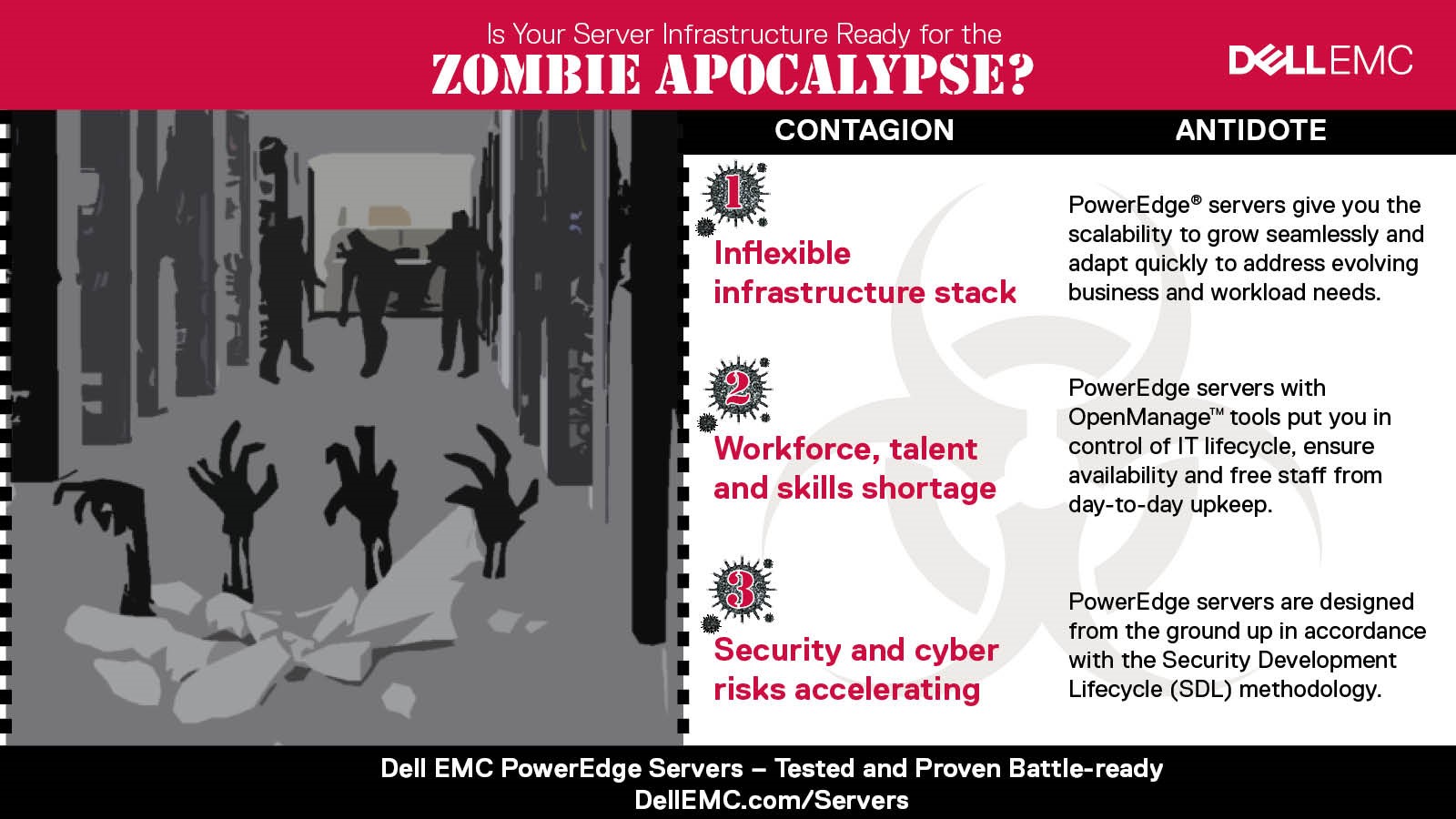Has your server infrastructure been inoculated against a zombie-related doomsday attack? We’re not talking power-draining, idle zombie servers. Or VM zombies. Or even zombie computers. We’re talking putrefied, brain-eating, somnambulistic monsters. Yeah, that kind, the kind that inhabit Max Brook’s The Zombie Survival Guide.

We ask because the unconventional thinking needed to survive a zombie apocalypse might inspire how you prepare your server infrastructure for digital transformation. Zombies, it turns out, are an excellent metaphor for learning how to survive when disruption reigns, when old world rules no longer apply. “Be prepared or be zombie-food” conveys about the same message as “keep your business relevant so you can outpace your competition.”
First step in your preparation, learn what you are trying to survive. Just as the virus Brooks calls “Solanum” turns people into zombies, the three contagions described below can zombify your infrastructure – make it lifeless, apathetic and unresponsive. But don’t panic, we also provide several practical survival tips.

First contagion: Inflexible infrastructure stack
Organizations understand business digitization brings huge opportunity. But most were not born “digital.” They need to modernize and transform business processes, applications and the use of data in ways that were not originally envisioned when their server infrastructure was built. Two of the most commonly cited barriers slowing digital progress are “insufficient budget and resources” and “infrastructure that doesn’t work at speed of business.” Just like zombies “that don’t adapt and they don’t think[i],” legacy infrastructure can be rigid, slow and arduous.
Survival tip: Invest in scalable and adaptable technologies
To deal with and accelerate the pace for modernization, place more emphasis on your infrastructure’s scalability, flexibility and agility. Look for favorable economics to both remain competitive and fund innovation.
With the performance to drive today’s applications, Dell 14th generation PowerEdge servers have scalability to grow seamlessly and to adapt quickly to address ever-evolving business and workload needs. The portfolio is enhanced to increase performance and response time, enable quick-and-easy deployment, and tailor the compute and storage configurations to your specific needs. And if you replace your 3+ year old servers[ii], the new servers will cost 59 percent less to operate over the next 3 years. Your IT infrastructure costs will be reduced by 61 percent. Making funding innovation possible.
Second contagion: Workforce, talent and skills shortage
IDC states that “by the end of 2019, 70 percent of companies engaged in data center transformation efforts will struggle to translate business needs into effective IT investments and operations plans.[iii]” That is likely because they don’t have the right in-house skills needed to build and execute an effective transformation.[iv] This is a challenge for many businesses but especially those with legacy server infrastructure. Teams responsible for IT infrastructure spend much more time on routine support and maintenance tasks, time that could be better used in innovation or supporting business expansion.
Survival tip: Enhance operational efficiency and productivity
To reduce or even eliminate the time IT staff spend on routine support and maintenance tasks, streamline automation technologies, increase the use of scalable management and self-provisioning.
Intelligent management in PowerEdge servers puts you in control of IT lifecycle, ensures server availability, and frees IT staff from day-to-day upkeep. (As stated in our touchstone The Zombie Survival Guide, “There may be times when it seems wasteful to send an entire team to do one person’s job.[v]”) The technology embedded in PowerEdge servers along with Dell OpenManage tools allows your servers to take care of themselves, automating deployment and on-going maintenance. The integrated Dell Remote Access Controller (iDRAC9) with Lifecycle Controller makes quick work of updates, monitoring and management with its integration with OpenManage Enterprise and other consoles like Microsoft System Center and VMware vCenter. ProSupport Plus and SupportAssist proactive predictive an automated support technology enables up to 90 percent faster resolution and reporting.
Third contagion: Security and cyber risks accelerating
Just as digital transformation is changing industries and creating opportunities it is also attracting a new class of malicious adversaries. For many IT professionals, security concerns – including cybercrime and espionage, and malware – are the top digital transformation challenges[vi]. The potential for system downtime, lost productivity, lost revenue, corrupted data and damaged corporate reputation are all reasons for the continuing and increasing concern. “Avoid ‘accidents’ waiting to happen.[vii]” Data center security is paramount to business success and the security of the underlying server infrastructure is critical.
Survival tip: Build on a stable and secure server infrastructure
Secure through solutions that are built-in, not bolted on. Shift from permission-based security to an intelligence-based risk management approach that makes securing more flexible and reduces the amount of risk.
For Dell, security is the starting point, not an afterthought. The integrated cyber resilient architecture security features of PowerEdge servers are designed from the ground up in accordance with the Security Development Lifecycle (SDL), a robust methodology that is an integral part of our overall hardware and firmware design. The end-to-end security solution blocks malicious attacks through a hardware root of trust, immutable keys burned into silicon authenticates server boot and firmware. Other protections include system image lockdown, an industry-first feature that prevents configuration changes that create security vulnerabilities and expose sensitive data and secure default passwords. Reliable detection is critical to swift spotting of malicious activities. This includes configuration and firmware drift protection, persistent event logging and secure alerting if abnormal activity is detected. Further Dell rapid recovery capabilities can, if necessary, restore critical operations back to a trusted base. These capabilities include automatic bios recovery and rapid OS recovery. In addition to prevent sensitive data from getting into malicious hands, Dell secure system erase enables IT to securely and instantly wiped data using cryptographic techniques.
Don’t go it alone
We hope you use this survival guide to prevent the zombification of your server infrastructure. And as Brooks writes, “Working together, always together, has shown to be the only successful strategy for annihilating an undead army.[viii]” Dell PowerEdge servers are here for you.
[i] Max Brooks, The Zombie Survival Guide, Complete Protection from the Living Dead (New York, NY, Broadway Books, 2003)
[ii] Matthew Marden and Ashish Nadkarni, “Accelerate Business Agility with Faster Server Refresh Cycles, #US42505917” (IDC, May 2017)
[iii] Cushing Anderson, “Digital Transformation: The CIO’s Sills Imperative” (IDC Blog, February 2018)
[iv] Ibid
[v] Brooks, 130
[vi] HelpNetSecurity, “Security concerns remain a top challenge for digital transformation” (Retrieved from http://www.helpnetsecurity.com on 3/28/18)
[vii] Brooks, 86
[viii] Brooks, 125